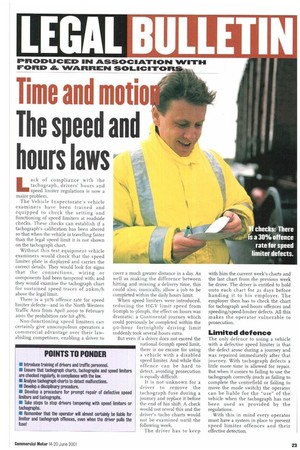LEGAL
Page 23

If you've noticed an error in this article please click here to report it so we can fix it.
IPFtOcsucm, 1141 ASSOCIATION WITH FC•Ftl,& WARREN 0411.101-1-01Ft
Time and moth) The speed and hours laws
Lack of compliance with the tachograph, drivers hours and speed limiter regulations is now a major problem.
The Vehicle Inspectorate's vehicle examiners have been trained and equipped to check the setting and functioning of speed limiters at roadside checks. These checks can establish if a tachograph's calibration has been altered so that when the vehicle is travelling faster than the legal speed limit it is not shown on the tachograph chart.
Without this test equipment vehicle examiners would check that the speed limiter plate is displayed and carries the correct details. They would look for signs that the connections, wiring or components had been tampered with; and they would examine the tachograph chart for sustained speed traces of zokm/h above the legal limit.
There is a 30% offence rate for speed limiter defects—and in the North Western Traffic Area from April 2000 to February 2001 the prohibition rate hit 48%.
Non-functioning speed limiters can certainly give unscrupulous operators a commercial advantage over their lawabiding competitors, enabling a driver to
cover a much greater distance in a day. As well as making the difference between hitting and missing a delivery time, this could also, ironically, allow a job to be completed within the daily hours limit.
When speed limiters were introduced, reducing the HGV limit speed from 6omph to 56mph, the effect on hours was dramatic: a Continental journey which could previously be completed within the 90-hour fortnightly driving limit suddenly took several hours extra.
But even if a driver does not exceed the national 6omph speed limit, there is no excuse for using a vehicle with a disabled Teed limiter. And while this offence can be hard to detect, avoiding prosecution is equally difficult.
It is not unknown for a driver to remove the tachograph fuse during a journey and replace it before the end of his shift. A check would not reveal this and the driver's tacho charts would not be examined until the following week.
The driver has to keep
with him the current week's charts and the last chart from the previous week he drove. The driver is entitled to hold onto each chart for zi days before handing it to his employer. The employer then has to check the chart for tachograph and hours offences and speeding/speed-limiter defects. All this makes the operator vulnerable to prosecution.
Limited defence
The only defence to using a vehicle with a defective speed limiter is that the defect arose during a journey and was repaired immediately after that journey. With tachograph defects a little more time is allowed for repair. But when it comes to failing to use the tachograph correctly (such as failing to complete the centrefield or failing to move the mode switch) the operator can be liable for the "use" of the vehicle when the tachograph has not been used as provided by the regulations.
With this in mind every operator must have a system in place to prevent speed limiter offences and their effective detection.
































































































